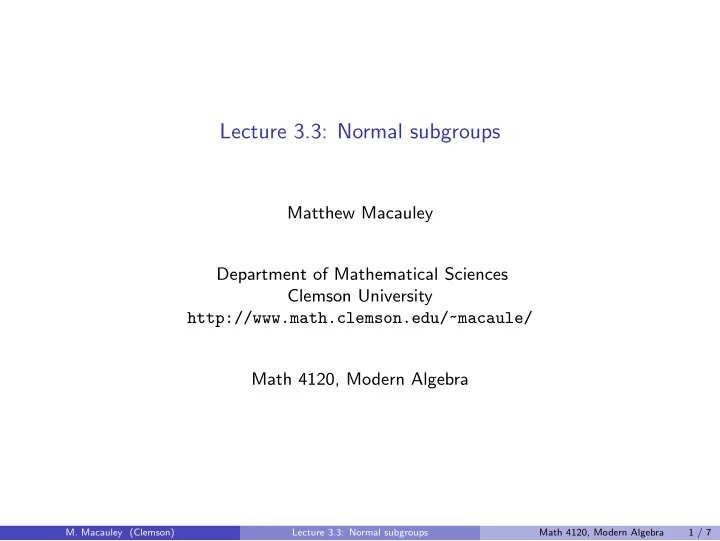

Lecture 3.3: Normal subgroups Matthew Macauley Department of Mathematical Sciences Clemson University http://www.math.clemson.edu/~macaule/ Math 4120, Modern Algebra M. Macauley (Clemson) Lecture 3.3: Normal subgroups Math 4120, Modern Algebra 1 / 7
Overview Last time, we learned that for any subgroup H ≤ G : the left cosets of H partition G ; the right cosets of H partition G ; these partitions need not be the same. Here are some visualizations of this idea: g n H Hg n H . g n H . g 1 H . Hg 2 . . . g n 1 H g 2 H − g 2 H g 1 H Hg 1 . . . H H Subgroups whose left and right cosets agree have very special properties, and this is the topic of this lecture. M. Macauley (Clemson) Lecture 3.3: Normal subgroups Math 4120, Modern Algebra 2 / 7
Normal subgroups Definition A subgroup H of G is a normal subgroup of G if gH = Hg for all g ∈ G . We denote this as H ⊳ G , or H � G . Observation Subgroups of abelian groups are always normal, because for any H < G , aH = { ah : h ∈ H } = { ha : h ∈ H } = Ha . Example Consider the subgroup H = � (0 , 1) � = { (0 , 0) , (0 , 1) , (0 , 2) } in the group Z 3 × Z 3 and take g = (1 , 0). Addition is done modulo 3, componentwise. The following depicts the equality g + H = H + g : (0 , 0) (0 , 1) (0 , 2) (0 , 0) (0 , 1) (0 , 2) (1 , 0) (1 , 1) (1 , 2) (1 , 0) (1 , 1) (1 , 2) (2 , 0) (2 , 1) (2 , 2) (2 , 0) (2 , 1) (2 , 2) M. Macauley (Clemson) Lecture 3.3: Normal subgroups Math 4120, Modern Algebra 3 / 7
Normal subgroups of nonabelian groups Since subgroups of abelian groups are always normal, we will be particularly interested in normal subgroups of non-abelian groups. Example Consider the subgroup N = { e , r , r 2 } ≤ D 3 . The cosets (left or right) of N are N = { e , r , r 2 } and Nf = { f , rf , r 2 f } = fN . The following depicts this equality; the coset fN = Nf are the green nodes. f f fN Nf e e r 2 r r 2 r r 2 f r 2 f rf rf M. Macauley (Clemson) Lecture 3.3: Normal subgroups Math 4120, Modern Algebra 4 / 7
Normal subgroups of nonabelian groups Here is another way to visualze the normality of the subgroup, N = � r � ≤ D 3 : r 2 f r 2 f fN f rf Nf f rf e r r 2 e r r 2 N N On contrast, the subgroup H = � f � ≤ D 3 is not normal: r 2 H r 2 f r 2 r 2 f r 2 Hr 2 Hr r r rH rf rf e e H f H f Proposition If H is a subgroup of G of index [ G : H ] = 2, then H ⊳ G . M. Macauley (Clemson) Lecture 3.3: Normal subgroups Math 4120, Modern Algebra 5 / 7
Conjugate subgroups For a fixed element g ∈ G , the set gHg − 1 = { ghg − 1 | h ∈ H } is called the conjugate of H by g . Observation 1 For any g ∈ G , the conjugate gHg − 1 is a subgroup of G . Proof 1. Identity: e = geg − 1 . � 2. Closure: ( gh 1 g − 1 )( gh 2 g − 1 ) = gh 1 h 2 g − 1 . � 3. Inverses: ( ghg − 1 ) − 1 = gh − 1 g − 1 . � � Observation 2 gh 1 g − 1 = gh 2 g − 1 if and only if h 1 = h 2 . � On the homework, you will show that H and gHg − 1 are isomorphic subgroups. (Though we don’t yet know how to do this, or precisely what it means.) M. Macauley (Clemson) Lecture 3.3: Normal subgroups Math 4120, Modern Algebra 6 / 7
How to check if a subgroup is normal If gH = Hg , then right-multiplying both sides by g − 1 yields gHg − 1 = H . This gives us a new way to check whether a subgroup H is normal in G . Useful remark The following conditions are all equivalent to a subgroup H ≤ G being normal: (i) gH = Hg for all g ∈ G ; (“left cosets are right cosets”); (ii) gHg − 1 = H for all g ∈ G ; (“only one conjugate subgroup”) (iii) ghg − 1 ∈ H for all g ∈ G ; (“closed under conjugation”). Sometimes, one of these methods is much easier than the others! For example, all it takes to show that H is not normal is finding one element h ∈ H for which ghg − 1 �∈ H for some g ∈ G . As another example, if we happen to know that G has a unique subgroup of size | H | , then H must be normal. (Why?) M. Macauley (Clemson) Lecture 3.3: Normal subgroups Math 4120, Modern Algebra 7 / 7
Recommend
More recommend